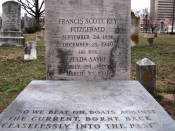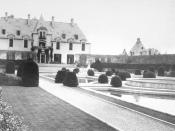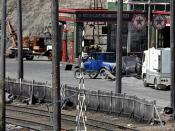Insert Societal Waste Here In the book The Great Gatsby, the symbol of the Valley of Ashes is very significant to one of its underlying themes. The valley of ashes is metaphorically representative of societal issues in the 1920s. The ash heap is shown as a symbol of destruction that spreads to destroy dreams and aspirations of the hopeful. Fitzgerald employs ties in the symbol of Dr. T.J.Eckleburg's billboard to the valley of ashes, to show the wastefulness of American society.
The Valley of Ashes represents the modern world. It's really a crude hell created by our modern society. This ash heap is really a garbage dump located just outside of New York City. Occasionally, "ash-grey men swarm up with leaden spades and stir up an impenetrable cloud which screens their obscure operation from your sight" (Pg. 17). They remove the trash of NYC and bring it to the ash heap to burn until it finally turns to ashes.
The men shoveling the trash off the train is like digging up dirt for a grave to bury someone. The ashes are what is left over after the trash's been burnt; it's the residue left over after destruction. The ash heap reminds us of death and decay. It is described as "the grey land and the spasms of bleak dust which drift endlessly over" (Pg. 27). The burning of the garbage is akin to ignition of the human essence, passions, desires, dreams, all aflame in a final blast of glory, until all that's left over is a thin layer of ashes, functional deadness of the soul.
Jay Gatsby dreams the great American dream of being wealthy, and his hope of someday being with Daisy, until his dreams take an unexpected turn into the ash heap, being reduced to residue. It is in the valley of the ashes where Tom has his affair with Myrtle, where Daisy kills Myrtle with Gatsby's car, and where George Wilson decides to murder Gatsby.
"a fantastic farm where ashes grow like wheat into ridges and hills and grotesque gardens, where ashes take the forms of houses and chimneys and rising smoke and finally, with a transcendent effort, of men who move dimly and already crumbling through the powdery air" (Pg. 27).
F. Scott Fitzgerald criticizes the wasteful tendencies of American society in his novel, The Great Gatsby. He uses the valley of ashes to comment on this aspect of American society. The valley of ashes is a bleak area situated between the West Egg and New York City. This unpleasant wasteland is located right along the roadway and train route between the eggs, home of the lofty aristocrats, and New York City, the exciting and fashionable metropolis where many of the nations wealthiest people live, work, and entertain themselves. Referring to an eye doctor's billboard in the valley of ashes, Nick, our narrator comments: "Evidently some wild wag of an oculist set them there to fatten his practice in the borough of Queens, and then sank down himself into eternal blindness or forgot them and moved away. But his eyes dimmed a little by many painless days under sun and rain, brood on over the solemn dumping ground" (Pg. 23). He is portraying the American habit of using up what is useful or has value and leaving the waste products behind.







